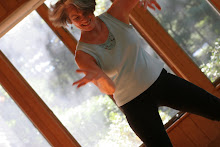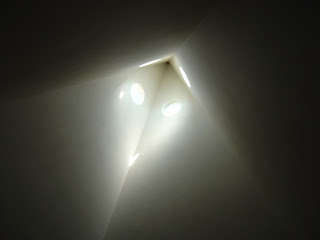Israel Supreme Court, Israel Museum, and a
visit to French Hill Masorti Rabba Chaya Baker
Our guide Ronny explained an
important reality in current Israeli political culture. Arab and ultra orthodox families in Israel are
poorer in general because they have more children and they seldom have more
than one income. Families that have more than six children get a tax break.
This creates a greater tax burden on the middle class. In previous generations, life was harder but
there was a greater feeling of solidarity.
Our first stop on this sixth day
of our trip, Thursday, December 8, 2011, was to Government Hill on the
outskirts of Jerusalem for a visit to the new Supreme Court building. The Minister of Foreign Affairs office is
across the street. Hebrew University is
across the hill.
The area
of the court’s jurisdiction is all of Israel and the Israeli-occupied territories. The Court has ruled on numerous issues
relating to the Israeli-Palestinian conflict, the rights
of Arab citizens of Israel, and on
discrimination between Jewish groups in Israel.
It is unique in that its rulings can intervene in Israel Defense Forces military
operations. The building was opened in 1992,
designed by noted architect Ram Karmi and his wife Ada Karmi-Melamede. It was donated to Israel by Dorothy de
Rothschild.
The building is a blend of enclosed and
open spaces, old and new, lines and circles.
Approaching the Supreme Court library, one enters the pyramid area, a
large space that serves as a turning point before the entrance to the
courtrooms. This serene space acts as the inner "gate house" of the
Supreme Court building. Natural light
enters round windows at the apex of the pyramid, forming circles of sunlight on
the inside walls and on the floor. Circular
shapes are featured in the design throughout the building.

In the afternoon, we visited the Israel
Museum. A quick stop at the museum café
featured a surprisingly fresh and delicious salad that tasted like I was
standing in a garden eating just-picked vegetables. This standard of freshness is not at all
unusual in Israeli food. We spent a long
time examining the model of Herodian Jerusalem in the courtyard of the museum,
and the collection of Dead Sea Scrolls and other ancient manuscripts in the
Shrine of the Book.
I was disappointed that our time inside
the museum was so short. There was so
much to see: magnificent displays of
every aspect of Judaica as well as impressive collections of art from every
part of the world and every period. When
the group was ready to depart on the bus, Rabbi Weiner suggested that I stay a
little longer and take a cab or bus back to the hotel. It was my first time on the trip to venture
out on my own, separate from the tour bus.
I took his advice and extended my stay long enough to visit the exhibit
of synagogues from Surinam, India, Germany, and Italy that had donated their
artifacts to the museum. It was a
memorable experience to step inside each one of these environments that had
been so lovingly reconstructed to represent Jewish life in each community. The beauty of each setting reflected the
climate and culture of the region.
I found a cab waiting in front of the
museum with a Russian cab driver who had lived for many years in Canada and
spoke English easily. On the short drive
back to the hotel, he told me his opinions about various hotels and tourist
attractions in the city and gave me a running description of the fashionable
neighborhood of Rehavia we were driving through. He gave me his card and said I should call
him wherever I might be if I need a cab.
I was happy to have made this connection.
In
the evening, our group went to the French Hill Masorti synagogue in northern
Jerusalem to hear Rabba Chaya Baker speak about her experiences as spiritual
leader in that community. The French
Hill congregation is one of the flagship congregations of the Masorti movement in
Israel. They endured many years with
no rabbi; this is Chaya’s fifth year as rabbi there. She is married with three daughters. Her husband’s family was one of the founding
families of the congregation, one important reason why she was able to get the
job. In witnessing her energy, wisdom,
enthusiasm, and creativity, it is apparent why she still has the job and is
serving a growing congregation.
Israel
is in a tough situation vis a vis Jewish religious life. There are secular and religious divisions in
schools and in the army. The official
religion of Israel is orthodox, tending toward ultra orthodox, although many
people who are members of orthodox congregations are affiliated in name
only. They want the shul they don’t go
to to be an orthodox one. In case they
need a rabbi or a minyan for a life cycle event, they have an affiliation. Otherwise, they are not observant, involved,
or engaged by Jewish life and thought.
There
are many social issues decided by the religious government that affect every
citizen, such as “Who can marry?” In
Israel, the only marriage sanctioned by the government is a religious marriage. In order to be married in Israel, you have to
prove that you are Jewish enough to pass muster with the orthodox religious
authorities. Those who cannot or do not
provide such proof are forced to marry elsewhere. There is a thriving industry of weddings in
nearby Cyprus for such couples.
Secular
people are resentful about the political power of religious authorities who
make decisions that affect them directly.
For example, many families consist of an orthodox father and a reform
mother. Chaya’s husband grew up in the Tali
school system which is a quasi-religious school system that serves families who
want some religious training in the school, but reject orthodox teachings.
For
the last five years, Chaya has been developing programs that expose secular
Jews in the French Hill commuinty to different ways to engage as a Jew. In Israel, Jewish identity *is* in conflict
with modern life. She is searching for
ways to build bridges between those who live a modern lifestyle and their
desire for connection to Judaism.
For
example, humane treatment of animals is a moral imperative taught in the Torah
and Talmud. Hospitality in the Jewish
home is strongly connected to Jewish tradition, customs, and philsophy. One reform Jewish mother reported to Chaya
how her daughter had taught her about counting the Omer between Passover and
Shavuot.
Chaya’s
approach is very delicate, very gentle, reaching out in a way that keeps people
from feeling embarrassed about what they know or don’t know. She connects a Jewish value to a story or a skit
in a program that includes children and their parents as much as possible.
As
with every congregation, she battles the concept of a drop-off mentality,
pediatric Judaism that is appropriate only for children. When she has program for children only, she
always includes something for them to take home. Before high holidays, for example, she
teaches about the meaning and function of the shofar and gives children and
their parents a chance to handle a shofar and try it out.
One
program called Modern MIKI has 35 kids and their parents enrolled. An average of 50 kids attend each function,
including those who are visiting and shopping.
Mini MIKI, a program for younger children, has 20 kids. She has Shabbat activities for children and
their parents on Friday night and Shabbat morning, including Kabbalala
Hashabbat .
She
has created a parent training program to run programming for young
children. Parents who are participating
in synagogue activities say, "I can't believe I'm in synagogue!” Sixteen
children are in the synagogue preschool.
Chaya
Baker chooses to use the title “rabba,” a designation of ordination for a woman
rabbi. Many people ask her, “What’s a
rabba?” She answers that it’s like a
rav, but it’s a woman.
For
one child in the synagogue’s programs Chaya was the only rabbi he had ever
known. When he heard someone mention a
rabbi, he asked Chaya, “Mah hu rav? (What is a rabbi?)” She answered that it's like a rabba, but it's
a man. Score one for Chaya who brought
a secular family unfamiliar with Jewish religious life closer to feeling
engaged.
Conservative
synagogues, schools, and programming receive no government support, whereas
orthodox synagogues are supported by government grants. One conservative synagogue got the court to
force the government to finance the building of their synagogue.
The
synagogue in French Hill is the victim of frequent vandalism. It’s a border neighborhood adjacent to a
hostile Arab village and hostile orthodox Jewish neighbors. The conservative congregation is hated by
both groups for different reasons. It is
not always clear who the perpetrators of the vandalism are or what their
reasons are.
Many
people in Israel identify as Jewish, but are not halachically Jewish. There are 64 Masorti synagogues in Israel, 11 in Jerusalem. Chaya is the only woman rabbi among he 64
congregations.
The
idea that “we are one Jewish people” is not helpful in practice. American support has made life more difficult
for the Masorti movement. American Jews
sometimes contribute to religious efforts in Israel that hurt Masorti
congregations. For example, absorption
centers in Israel teach Judaism to newcomers.
In the past, reform and conservative congregations have participated in
these efforts. Recently reform and
conservative participation was ended because funding for the project was
threatened if they continued.
Chaya
says, “What about pluralism, freedom of choice?”
Our
group asks, “What can we do to help?”
She answers, “Care. Campaign to get people to come back to Israel. Some financial contributions to programs in
Israel are ill thought out. Be careful
to whom you give your money.” She
congratulated all of us for our efforts to travel to Israel and expose
ourselves to lots of experiences while there.
Masorti
congregations are forced to support themselves with dues paid by members,
unlike orthodox synagogues that are supported by tax money.
At
the end of Chaya’s presentation, we chose to pass a hat and made a contribution
to her efforts. Many expressed an
interest in addressing the issues mentioned with Arlene and the Jewish
Federation of the Berkshires and with our congregations at home.





0 Comments:
Post a Comment
Subscribe to Post Comments [Atom]
<< Home